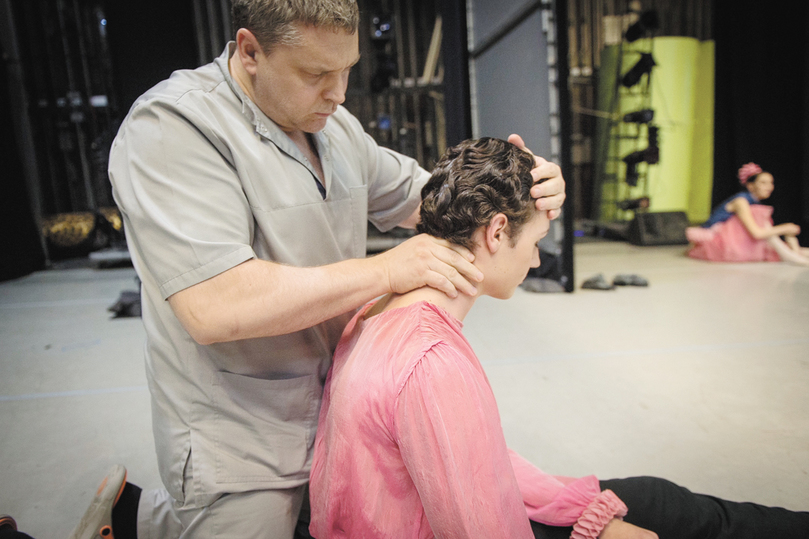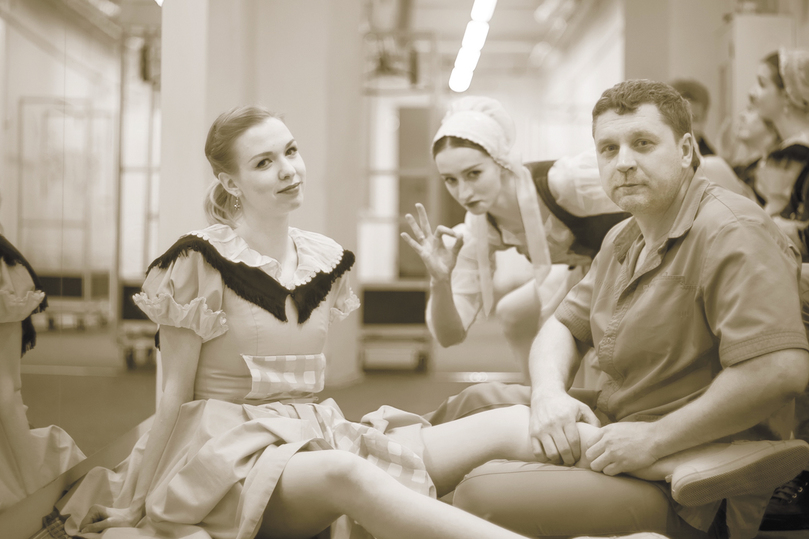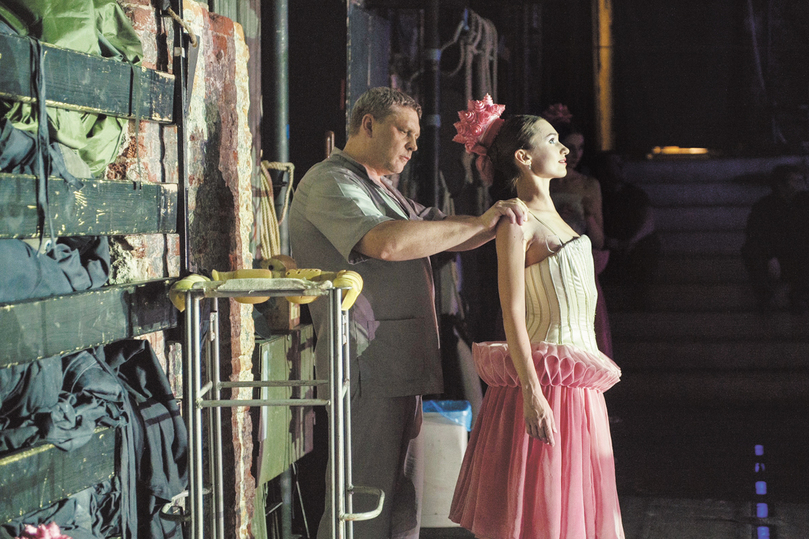“They bring the soloist backstage”: the masseur described ballet injuries
[ad_1]
FROM THE DOSIER “MK”
Igor Kazusev is a paramedic, rehabilitation specialist, kinesio, viscero and yumeiho therapist. Graduated from LMU them. Chudnovsky. Since 1991 he has been working as a sports massage therapist, as a ballet massage therapist he has been practicing for 15 years at the Mikhailovsky Theater, where he was invited by Farukh Ruzimatov.
You have pointe shoes, we have helmets
— The position of masseur in ballet troupes existed in pre-revolutionary times. Yes, and in the Soviet Union in the theater it was a must, – says Igor Borisovich. – And here we are talking about massage in the broadest sense of the word: for example, I constantly monitor the condition of the artists, watch their loads. When I started working with ballet, I was always surprised how a girl with such a thin ankle and calf muscle, which visually, as it were, is halfway there, lifts her weight during rotation or other movements? The same is true for thin-looking guys who can carry a partner on one arm.
“You often hear the following expression about a ballet school: “they break a leg” – that’s what they say when girls in the school put a leg in. And how does this “breakdown” literally occur?
– Nobody breaks anything for anyone – this is the system of setting the foot, the education of the artist. And not even breaking, but stretching, preparing a beautiful foot. And this is not only the foot, but the general stretching, splits, something else. And here, of course, beauty is through pain.
– A ballerina on pointe shoes is really beautiful, but it hurts. What happens to her foot and fingers at this moment?
– In St. Petersburg, they say not pointe shoes, but helmets. But this is our St. Petersburg difference from Moscow definitions: you have a curb, we have a curb, you have white bread, we have a roll, in ballet you have a machine tool, and we have a stick. And the same story with pointe shoes. When standing on the toes, there really is an unnatural load on the foot, on the joint, which, of course, is not good for the body – a person should not walk on the toes. From this, ballerinas very often experience arthrosis, hallux valgus, in other words, the bones come out. And ballerinas protect themselves by using silicone inserts between their fingers in helmets, that is, in pointe shoes. For my part, it is important to help the artist protect the foot from stress loads, using massage, vibration techniques, kinesio taping, that is, the application of tapes that regulate the work of muscles, ligaments, and create a soft orthosis.
– In the darkness of the backstage, by touch on the foot, can you determine which ballerina’s foot belongs to?
– In many cases, yes. And also, if you do not see the face of the artist, I can tell whose back, and this is not an exaggeration.

The sexual question in ballet is acute
– If we compare a dancer with a ballerina in support and a weightlifter with a barbell, are these the same loads?
– The question is interesting. Both in ballet and in sports, the loads are colossal. The difference is that if a ballet dancer always works with medium weights (from 50 to 60 kg), then a weightlifter works with large ones, and this leads to an increase in his muscle mass. Athletes work with a jerk, and ballet dancers unanimously say that in ballet a lot depends on technique, and not just on physical strength.
Nevertheless, this is an incorrect comparison – ballet and weightlifters have different tasks. Ballet dancers must show emotions, and, unlike weightlifters, they cannot be shown the severity of the loads. They need to do everything easily, gracefully and in the language of ballet, gesture to talk to the audience and inspire him.
— How often and with what problems do ballerinas and dancers turn to you?
– Often. According to statistics, most often the guys tear the cruciate ligaments, muscles, their knees “fly”, there are fractures, dislocations, the ankle and Achilles tendon suffer. In general, it’s hard in ballet, and these are not complaints, but a fact. By the end of their career, many artists acquire a “pretty” set of occupational diseases – arthritis, arthrosis, they have pain in the metatarsal bones of the foot, intervertebral hernia, and myositis occurs. I’m not talking about constant stress from excessive loads.
But at the same time, the rehabilitation period after various injuries is short, but few people can withstand it – it has healed a little, they are already entering the stage. It is clear why – the century of ballet dancers is very short, they do not have time to build up, there is a lot to do. The soloist came to me: I rehabilitated him, but he still came out ahead of time and tore his ligaments again. As a result, he was forced to become a teacher, but he danced wonderfully and showed promise.

– How do you need to dance and what kind of movement to make to break the ligaments during the performance?
– This injury is usually typical for contact types of wrestling or when football players make tackles. At this moment, the leg goes to the side, the lower leg sharply deviates. The same thing happens in dance, and most often during jumps, especially when there are a lot of artists on the stage, and someone accidentally hit someone. And then a lot depends on gender.
Is the sexual question so acute in ballet?
– When I arrive at a new site, I always ask: “What is your gender?” It is very important for the legs, for the back: if, say, someone has an intervertebral hernia, an aggravation can occur. The floor should be specialized, shock-absorbing, in different theaters the slope is different – you have to adapt.
But the most important factor is the emotional state of the artist. Very often, during the performance, the artist runs backstage and does not feel what happened to him. And if he feels, then he endures, ballet dancers are generally very patient. And I had cases on tour when girls danced with fractures.
The emotional component in the ballet is very strong: the artist enters the image and becomes, as it were, a different person. And in order for him to feel the fracture, he must get out of this state. And now the artist runs backstage, and my task is to assess how serious the problem is. Therefore, I do not immediately give an assessment, first of all I look at my small beacons, what kind of injury, and when the emotional sphere fades, I start talking to them. I have a large paramedical practice, I worked in an ambulance, so everything is worked out here.

Suddenly, the artist is brought backstage in her arms – she has an open fracture
– The book of the great Russian ballerina Ekaterina Maximova describes the case of how she, at the rehearsal of the ballet “Ivan the Terrible”, without knowing the intricacies of the role, unsuccessfully left the support. It ended up that Maksimova lost the ability to move, and the doctors sentenced her to a wheelchair. And only thanks to long-term treatment, special classes, she returned to the stage. And Nikolai Tsiskaridze, after an injury received in France, seems to have not danced for a year.
– Such a case is not an exaggeration, but the terrible truth of ballet. God forbid, the mistake of one of the partners, and anything can happen. One wrong move of the partner in support – and the ballerina falls. One wrong move of the partner – and the partner’s back “flies”.
– And over the years of your work with the Mikhailovsky Theater ballet, what incident do you remember as a nightmare?
– There were serious injuries. There is a performance of “Spartacus”, and suddenly the soloist is brought backstage in her arms – she fell, she has an open fracture. Or another, with a dislocated knee joint – her patella has already shifted. There was also a torn ligament in the knee of the artist. Moreover, it is necessary to take into account the factor of pain shock, but the performance continues anyway. The viewer sees a beautiful picture, the curtain does not fall, and behind the scenes – first aid: anesthesia, immobilization, you need to understand whether there is a shock or not, determine the tactics of your actions before the ambulance arrives.
For some reason, everyone likes to scold us, but I can say from my work: the ambulance arrives much faster than in other countries. I remember that in Venice they called an ambulance to a ballerina – they waited for half an hour, and when she arrived, two doctors did not provide assistance – she was simply hospitalized. And with us, the paramedic would first give an injection with an antispasmodic, thus relieving the pain, and the actor would calmly get to the hospital. In general, my task, when I am on duty at a performance, is to evaluate, help and make a decision – can I dance / can’t, call an ambulance / not call, withdraw or not withdraw from the performance?
More recently, at the same Spartak, in fact, Spartak was smashed in the head with a sword. The injury itself is not life-threatening, but there was a lot of blood, and the audience thought it was fake. The artist was brought to me, I see that the wound on the head has already spread. Then I quickly treated it with an antiseptic, pressed it on top with ice, and connected the diverging tissues with adhesive tape. After that, the artist ran off to dance. But as the blood continued to flow, he ran backstage a few more times with his head covered in blood. They even arranged a place for me there. And only after the performance I was able to calmly put a bandage on him, and he went to the “injury”, where they sewed up his wound.
– But Spartak clearly had a concussion. Is it possible to dance in such a state?
— Of course not, but an artist is an artist. Such is his readiness, and I can say that this, of course, is heroism. With injuries, with tears, fractures, as a rule, they continue to dance. And my task is also to persuade the artists to go through a full rehabilitation and not rush to go on stage.
— New technologies to help ballet injuries?
– Now a lot comes from sports medicine to ballet. We actively use all new techniques: kinesio taping, vacuum therapy, percussion-vibration methods. But along with this, we also use oriental techniques, for example: gua sha (traditional Chinese medicine, translated as “I scrape out the bad”). I’m not talking about exercise therapy, warming ointments, our artists love the Japanese Yoko Yoko – we call it “eka yoka”.

These are not men in pantyhose, but real men
– Which choreography is more conducive to injury – classical or modern?
– Of course, classic. Modern is not so traumatic. When Nacho Duato came to Mikhailovsky, artists of all ages said that muscles work in a completely different way than in the classics. And in general, everything is different.
– Coming from sports to ballet, what did you discover in ballet and ballet dancers?
– With all the comparison, I can say that the ballet guys are very good guys. And moreover, I believe that a ballet dancer cannot be a bad person: there is always the support and shoulder of a friend. We went on tour, which lasted two months, and in two months you can recognize a person – I have never experienced disappointment. I admire their will, strength of character: a person on pills and injections is ready to go on stage – that’s cool.
I admire the masculine qualities of our dancers: despite their elegance, airiness, despite the fact that they are all princes, they are strong guys who can carry a woman on one arm. So these are not men in pantyhose, but real men. People often do not understand what is behind a beautiful and simple action – he picked up his partner and carried him. And behind him is a character that forms a man whom the partner trusts completely, trusts him with life. And is a man really just brutality and a mountain of muscles?
– Last question. In your practice, were there performances that did not have an emergency?
– Unfortunately no. There are only relatively calm ones. But in almost every performance there are definitely injuries, more or less serious.
[ad_2]
Source link






